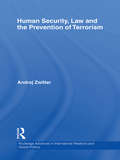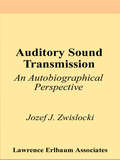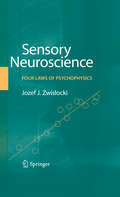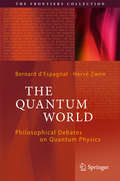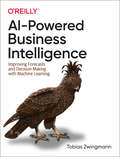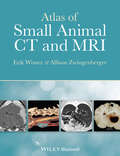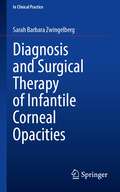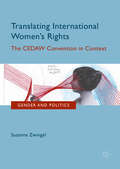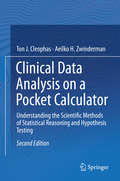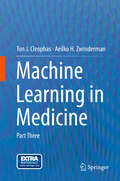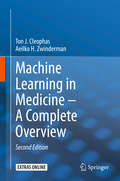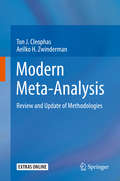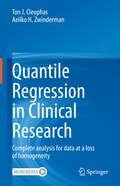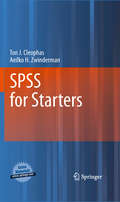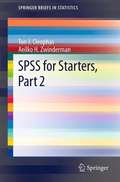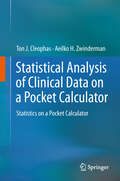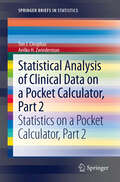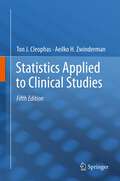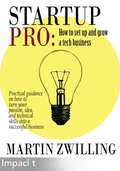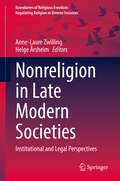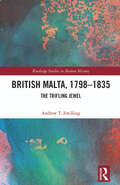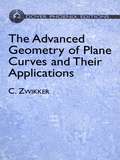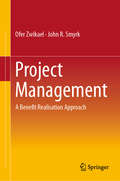- Table View
- List View
Human Security, Law and the Prevention of Terrorism (Routledge Advances in International Relations and Global Politics)
by Andrej ZwitterThis study examines two important questions regarding terrorism and political violence: which threats to human security constitute root causes for collective violence and which adequate responses for these root causes are available to the international community. The responses are examined on the basis of international law, in particular human rights law, and within the concept of human security, with the goal of fostering a long-term reduction in political violence. Drawing on existing political discussions and research about the root causes of terrorism, Zwitter develops a legal framework for the application of legal terrorism prevention tools. This study serves as a framework of action and analysis using concepts and particularly legal frameworks which are already broadly or universally recognized to increase the applicability of the framework without having to invent new legal regimes. In doing so it makes use of the concept of human security for tackling breeding grounds and other facilitators of terrorism making it universally accessible. Combining social science research with legal sociology and international law, this book will be of interest to students and scholars of politics, international relations, security studies, conflict studies and law.
Religious, Feminist, Activist: Cosmologies of Interconnection (Anthropology of Contemporary North America)
by Laurel ZwisslerIn Religious, Feminist, Activist, Laurel Zwissler investigates the political and religious identities of women who understand their social-justice activism as religiously motivated. Placing these women in historical context as faith-based activists for social change, this book discusses what their activities reveal about the public significance of religion in the pluralistic context of North America and in our increasingly globalized world. Zwissler’s ethnographic interviews with feminist Catholics, Pagans, and United Church Protestants reveal radically different views of religious and political expression and illuminate how individual women and their communities negotiate issues of personal identity, spirituality, and political responsibility. Political activists of faith recount adventurous tales of run-ins with police, agonizing moments of fear and powerlessness in the face of global inequality, touching moments of community support, and successful projects that improve the lives of others. Religious, Feminist, Activist combines religion, politics, and globalization—subjects frequently discussed in macro terms—with individual personalities and intimate stories to provide a fresh perspective on what it means to be religiously and politically engaged. Zwissler also provides an insightful investigation into how religion and politics intersect for women on the political left.
Auditory Sound Transmission: An Autobiographical Perspective
by Jozef J. ZwislockiAuditory Sound Transmission provides an integrated, state-of-the-art description and quantitative analysis of sound transmission from the outer ear to the sensory cells in the cochlea of the inner ear. It describes in detail the structures and mechanisms involved and gives their input and transmission characteristics. It shows how sound transmission in one part of the ear depends on the input characteristics of the next part and how sound is analyzed in the inner ear before it reaches the nervous system. The book is divided into seven chapters. The first gives the general overview of the path of sound in the ear. The second concerns the acoustics of the outer ear which is important not only for sound transmission in the ear but also for the design and calibration of earphones, as well as for clinical and research measurements of sound pressure in the ear canal. The third chapter analyzes the middle ear function which is crucial for adapting the conditions of sound propagation in the air to those in the inner ear fluids. The middle ear is prone to various malfunctions, and it is shown how they change the acoustic conditions measured in the ear canal and can be diagnosed on this basis. The next three chapters are dedicated to the most intricate mechanical part of the auditory system, the cochlea. Because of its complexity, its function is explained in three steps: first, with the help of simplifications produced by death; second, on the basis of the measured characteristics of the live organ; third, with the help of quantitative analysis. The last chapter describes cochlear mechanisms underlying pitch and loudness perception.
Sensory Neuroscience: Four Laws of Psychophysics
by Jozef J. ZwislockiSensory Neuroscience: Four Laws of Psychophysics organizes part of psychophysics -- a science of quantitative relationships between human sensations and the stimuli that evoke them. Although psychophysics belongs to sensory neuroscience, and is coupled to neurophysiology, it has also branched out to various specialized disciplines, including the disciplines of vision and hearing, ophthalmology, optometry, otology, and audiology. Due to this diversification and fragmentation, psychophysics has had an ad-hoc, phenomenological orientation. Besides Weber's law of differential sensitivity, and the still-controversial Stevens' power law, it has lacked a systematic grid of scientific laws. Sensory Neuroscience: Four Laws of Psychophysics provides valid unifying principles and systematic applications for this otherwise fragmented precursor of experimental psychology, and defines four multisensory relationships of substantial generality between sensations and the underlying stimulus variables. This book will be particularly useful to auditory researchers, experimental psychologists, and behavioral neuroscientists.
Christmas Cookies
by Lisa ZwirnDo you have a favorite Christmas cookie? Is it made of chocolate or spice? Is it an iced and decorated sugar cookie or a molasses ginger round? Or maybe it's a crisp, chocolate-covered toffee bar or a jam-filled Linzer sandwich cookie. There are so many choices! Christmas cookies are loved for their special shapes, cheery colors, and seasonal flavors. They bring joy to our gatherings, help preserve the magic and tradition of the holiday season, and make heart-warming gifts. Christmas Cookies offers fifty wonderful recipes for holiday treats, such as light-as-air Cocoa Meringue Kisses, Chocolate Peppermint Cookies that perfectly complement a mug of hot chocolate, sweet-tart Iced Lemon Rounds, the much-beloved classic Pecan Sandies, Ginger Coins with the right amount of snap, and many, many more. Avid holiday baker Lisa Zwirn baked hundreds of cookies to come up with these fabulous fifty recipes. There is something for everyone: treats for chocoholics, holiday shapes that children will love (that can be baked and decorated by the little ones, too), luxurious sandwich cookies, and plenty of spiced rounds, buttery wafers, and decadent bars. Christmas Cookies will also show you how to make the most of your time in the kitchen with these useful tips and ideas: Cookie baking guidelines for successful baking Options for freezing dough so you can bake cookies when the mood strikes Storage suggestions to help keep treats fresh for as long as possible Child-friendly recipes, such as Peanut Butter Chocolate Kisses, Chocolate Caramel Thumbprints, Gingerbread People, and Molasses Ginger Cookies, which are easy and fun for beginners The best cookies to mail and how to wrap them How to host a holiday cookie swap and cookie-decorating party Whether you've baked Christmas cookies for years or are just starting a tradition of holiday baking, you'll find all the recipes you need right here. Christmas Cookies is an essential collection for the cookie baker, featuring color photographs, clear, detailed recipes, and irrepressible Christmas spirit.
The Quantum World
by Hervé Zwirn Bernard D'EspagnatIn this largely nontechnical book, eminent physicists and philosophers address the philosophical impact of recent advances in quantum physics. These are shown to shed new light on profound questions about realism, determinism, causality or locality. The participants contribute in the spirit of an open and honest discussion, reminiscent of the time when science and philosophy were inseparable. After the editors’ introduction, the next chapter reveals the strangeness of quantum mechanics and the subsequent discussions examine our notion of reality. The spotlight is then turned to the topic of decoherence. Bohm’s theory is critically examined in two chapters, and the relational interpretation of quantum mechanics is likewise described and discussed. The penultimate chapter presents a proposal for resolving the measurement problem, and finally the topic of loop quantum gravity is presented by one of its founding fathers, Carlo Rovelli. The original presentations and discussions on which this volume is based took place under the auspices of the French “Académie des Sciences Morales et Politiques”. The book will appeal to everybody interested in knowing how our description of the world is impacted by the results of the most powerful and successful theory that physicists have ever built.
AI-Powered Business Intelligence: Improving Forecasts And Decision Making With Machine Learning
by Tobias ZwingmannUse business intelligence to power corporate growth, increase efficiency, and improve corporate decision making. With this practical book with hands-on examples in Power BI, you'll explore the most relevant AI use cases for BI, including improved forecasting, automated classification, and AI-powered recommendations. And you'll learn how to draw insights from unstructured data sources like text, document, images files.Author Tobias Zwingmann helps BI professionals, business analysts, and data analytics understand high-impact areas of artificial intelligence. You'll learn how to leverage popular AI-as-a-service and AutoML platforms to ship enterprise-grade proofs of concept without the help of software engineers or data scientists.Learn how AI can generate business impact in BI environmentsUse AutoML for automated classification and improved forecastingImplement recommendation services to support decision-makingDraw insights from text data at scale with NLP servicesExtract information from documents and images with computer vision servicesBuild interactive user frontends for AI-powered dashboard prototypesImplement an end-to-end case study for building an AI-powered customer analytics dashboard
Atlas of Small Animal CT and MRI
by Allison Zwingenberger Erik WisnerAtlas of Small Animal CT & MRI is a highly illustrated diagnostic imaging guide to common clinical disorders of dogs and cats. Contains over 3,000 high quality CT, MRI and related diagnostic images Offers a unique approach emphasizing comparative imaging and pathologic correlation Focuses on important imaging features relevant to imaging diagnosis of disease in dogs and cats Written by internationally renowned experts in the field
Diagnosis and Surgical Therapy of Infantile Corneal Opacities (In Clinical Practice)
by Sarah Barbara ZwingelbergThe book provides a condensed overview of the diagnostics, genetics and current treatment options for congenital corneal opacities and dysgenesis of the anterior segment of the eye. Concise yet detailed presentation of the most important clinical congenital corneal opacities and their differential diagnoses including color illustrations are depicted throughout the book.Diagnosis and Surgical Therapy of Infantile Corneal Opacities includes up-to-date and scientifically reviewed therapy options for specific congenital corneal diseases. Ophthalmologists seeking a clear and concise congenital corneal disease reference guide will find this book to be an indispensable resource in their daily clinical practice.
Translating International Women's Rights
by Susanne ZwingelThis book looks at the centerpiece of the international women's rights discourse, the Convention on the Elimination of all Forms of Discrimination against Women (CEDAW), and asks to what extent it affects the lives of women worldwide. Rather than assuming a trickle-down effect, the author discusses specific methods which have made CEDAW resonate. These methods include attempts to influence the international level by clarifying the meaning of women's rights and strengthening the Convention's monitoring procedure, and building connections between international and domestic contexts that enable diverse actors to engage with CEDAW. This analysis shows that while the Convention has worldwide impact, this impact is fundamentally dependent on context-specific values and agency. Hence, rather than thinking of women's rights exclusively as normative content, Zwingel suggests to see them as in process. This book will especially appeal to students and scholars interested in transnational feminism and gender and global governance.
Clinical Data Analysis on a Pocket Calculator: Understanding the Scientific Methods of Statistical Reasoning and Hypothesis Testing (SpringerBriefs in Statistics #0)
by Aeilko H. Zwinderman Ton J. CleophasInmedical and health care the scientific method is little used, and statisticalsoftware programs are experienced as black box programs producing lots ofp-values, but little answers to scientific questions. The pocket calculatoranalyses appears to be, particularly, appreciated, because they enable medicaland health professionals and students for the first time to understand thescientific methods of statistical reasoning and hypothesis testing. So much so,that it can start something like a new dimension in their professional world. Inaddition, anumber of statistical methods like power calculations and required sample sizecalculations can be performed more easily on a pocket calculator, than using asoftware program. Also, there are some specific advantages of thepocket calculator method. You better understand what you are doing. The pocketcalculator works faster, because far less steps have to be taken, averages canbe used. The current nonmathematical book is complementary to thenonmathematical "SPSS for Starters and 2nd Levelers" (Springer HeidelbergGermany 2015, from the same authors), and can very well be used as its dailycompanion.
Machine Learning in Medicine
by Aeilko H. Zwinderman Ton J. CleophasMachine learning is a novel discipline concerned with the analysis of large and multiple variables data. It involves computationally intensive methods, like factor analysis, cluster analysis, and discriminant analysis. It is currently mainly the domain of computer scientists, and is already commonly used in social sciences, marketing research, operational research and applied sciences. It is virtually unused in clinical research. This is probably due to the traditional belief of clinicians in clinical trials where multiple variables are equally balanced by the randomization process and are not further taken into account. In contrast, modern computer data files often involve hundreds of variables like genes and other laboratory values, and computationally intensive methods are required. This book was written as a hand-hold presentation accessible to clinicians, and as a must-read publication for those new to the methods.
Machine Learning in Medicine – A Complete Overview
by Aeilko H. Zwinderman Ton J. CleophasAdequate health and health care is no longer possible without proper data supervision from modern machine learning methodologies like cluster models, neural networks, and other data mining methodologies. The current book is the first publication of a complete overview of machine learning methodologies for the medical and health sector, and it was written as a training companion, and as a must-read, not only for physicians and students, but also for any one involved in the process and progress of health and health care.In this second edition the authors have removed the textual errors from the first edition. Also, the improved tables from the first edition, have been replaced with the original tables from the software programs as applied. This is, because, unlike the former, the latter were without error, and readers were better familiar with them.The main purpose of the first edition was, to provide stepwise analyses of the novel methods from data examples, but background information and clinical relevance information may have been somewhat lacking. Therefore, each chapter now contains a section entitled "Background Information".Machine learning may be more informative, and may provide better sensitivity of testing than traditional analytic methods may do. In the second edition a place has been given for the use of machine learning not only to the analysis of observational clinical data, but also to that of controlled clinical trials.Unlike the first edition, the second edition has drawings in full color providing a helpful extra dimension to the data analysis.Several machine learning methodologies not yet covered in the first edition, but increasingly important today, have been included in this updated edition, for example, negative binomial and Poisson regressions, sparse canonical analysis, Firth's bias adjusted logistic analysis, omics research, eigenvalues and eigenvectors.
Modern Meta-Analysis
by Aeilko H. Zwinderman Ton J. CleophasModern meta-analyses do more than combine the effect sizes of a series of similar studies. Meta-analyses are currently increasingly applied for any analysis beyond the primary analysis of studies, and for the analysis of big data. This 26-chapter book was written for nonmathematical professionals of medical and health care, in the first place, but, in addition, for anyone involved in any field involving scientific research. The authors have published over twenty innovative meta-analyses from the turn of the century till now. This edition will review the current state of the art, and will use for that purpose the methodological aspects of the authors' own publications, in addition to other relevant methodological issues from the literature. Are there alternative works in the field? Yes, there are, particularly in the field of psychology. Psychologists have invented meta-analyses in 1970, and have continuously updated methodologies. Although very interesting, their work, just like the whole discipline of psychology, is rather explorative in nature, and so is their focus to meta-analysis. Then, there is the field of epidemiologists. Many of them are from the school of angry young men, who publish shocking news all the time, and JAMA and other publishers are happy to publish it. The reality is, of course, that things are usually not as bad as they seem. Finally, some textbooks, written by professional statisticians, tend to use software programs with miserable menu programs and requiring lots of syntax to be learnt. This is prohibitive to clinical and other health professionals. The current edition is the first textbook in the field of meta-analysis entirely written by two clinical scientists, and it consists of many data examples and step by step analyses, mostly from the authors' own clinical research.
Quantile Regression in Clinical Research: Complete analysis for data at a loss of homogeneity
by Aeilko H. Zwinderman Ton J. CleophasQuantile regression is an approach to data at a loss of homogeneity, for example (1) data with outliers, (2) skewed data like corona - deaths data, (3) data with inconstant variability, (4) big data. In clinical research many examples can be given like circadian phenomena, and diseases where spreading may be dependent on subsets with frailty, low weight, low hygiene, and many forms of lack of healthiness. Stratified analyses is the laborious and rather explorative way of analysis, but quantile analysis is a more fruitful, faster and completer alternative for the purpose. Considering all of this, we are on the verge of a revolution in data analysis. The current edition is the first textbook and tutorial of quantile regressions for medical and healthcare students as well as recollection/update bench, and help desk for professionals. Each chapter can be studied as a standalone and covers one of the many fields in the fast growing world of quantile regressions. Step by step analyses of over 20 data files stored at extras.springer.com are included for self-assessment. We should add that the authors are well qualified in their field. Professor Zwinderman is past-president of the International Society of Biostatistics (2012-2015) and Professor Cleophas is past-president of the American College of Angiology(2000-2002). From their expertise they should be able to make adequate selections of modern quantile regression methods for the benefit of physicians, students, and investigators.
SPSS for Starters
by Aeilko H. Zwinderman Ton J. CleophasThis small book contains all statistical tests that are relevant for starters on SPSS. Each test is explained using a data example from clinical practice, including every step in SPSS and the main tables of results with an accompanying text with interpretations of the results and hints convenient for data reporting, i.e., scientific clinical articles and poster presentations.. In order to facilitate the use of this cookbook the data files of the examples are made available by the publisher on the Internet. For investigators who wish to perform their own data analyses from the very start the book can be used as a step-by-step guideline. They can enter their separate data or enter their entire data file, e.g., from Excel, simply by opening an Excel file in SPSS. SPSS statistical software is a user-friendly statistical software with many help and tutor pages. However, for the novices on SPSS an even more basic approach is welcome. The book is meant for this very purpose, and can be used without the help of a teacher. The authors are well-aware that this cookbook contains a minimal amount of text and a maximal technical details, but we believe that this property will not refrain students from mastering the SPSS software systematic, and that, instead, it will even be a help to that aim. Yet, we recommend that it be used together with the textbook "Statistics Applied to Clinical Trials" by Cleophas et al, 4th Edition, 2009, Springer Dordrecht.
SPSS for Starters, Part 2
by Aeilko H. Zwinderman Ton J. CleophasThe first part of this title contained all statistical tests that are relevant for starters on SPSS, and included standard parametric and non-parametric tests for continuous and binary variables, regression methods, trend tests, and reliability and validity assessments of diagnostic tests. The current part 2 of this title reviews multistep methods, multivariate models, assessments of missing data, performance of diagnostic tests, meta-regression, Poisson regression, confounding and interaction, and survival analyses using log tests and segmented time-dependent Cox regression. Methods for assessing non linear models, data seasonality, distribution free methods, including Monte Carlo methods and artificial intelligence, and robust tests are also covered. Each method of testing is explained using a data example from clinical practice,including every step in SPSS, and a text with interpretations of the results and hints convenient for data reporting. In order to facilitate the use of this cookbook the data files of the examples is made available by the editor through extras.springer.com. Both part 1 and 2 of this title contain a minima amount of text and maximal technical details, but we believe that this property will not refrain students from mastering the SPSS software systematics, and that, instead, it will be a help to that aim. Yet, we recommend that it will used together with the textbook "Statistics Applied to Clinical Trials" (5th edition, Springer, Dordrecht 2012) and the e-books "Statistics on a Pocket Calculator Part 1 and 2 (Springer, Dordrecht, 2011 and 2012) from the same authors.
Statistical Analysis of Clinical Data on a Pocket Calculator
by Aeilko H. Zwinderman Ton J. CleophasThe core principles of statistical analysis are too easily forgotten in today's world of powerful computers and time-saving algorithms. This step-by-step primer takes researchers who lack the confidence to conduct their own analyses right back to basics, allowing them to scrutinize their own data through a series of rapidly executed reckonings on a simple pocket calculator. A range of easily navigable tutorials facilitate the reader's assimilation of the techniques, while a separate chapter on next generation Flash prepares them for future developments in the field. This practical volume also contains tips on how to deny hackers access to Flash internet sites. An ideal companion to the author's co-authored works on statistical analysis for Springer such as Statistics Applied to Clinical Trials, this monograph will help researchers understand the processes involved in interpreting clinical data, as well as being a necessary prerequisite to mastering more advanced statistical techniques. The principles of statistical analysis are easily forgotten in today's world of time-saving algorithms. This step-by-step primer takes researchers back to basics, enabling them to examine their own data through a series of sums on a simple pocket calculator.
Statistical Analysis of Clinical Data on a Pocket Calculator, Part 2
by Aeilko H. Zwinderman Ton J. CleophasThe first part of this title contained all statistical tests relevant to starting clinical investigations, and included tests for continuous and binary data, power, sample size, multiple testing, variability, confounding, interaction, and reliability. The current part 2 of this title reviews methods for handling missing data, manipulated data, multiple confounders, predictions beyond observation, uncertainty of diagnostic tests, and the problems of outliers. Also robust tests, non-linear modeling , goodness of fit testing, Bhatacharya models, item response modeling, superiority testing, variability testing, binary partitioning for CART (classification and regression tree) methods, meta-analysis, and simple tests for incident analysis and unexpected observations at the workplace and reviewed. Each test method is reported together with (1) a data example from practice, (2) all steps to be taken using a scientific pocket calculator, and (3) the main results and their interpretation. Although several of the described methods can also be carried out with the help of statistical software, the latter procedure will be considerably slower. Both part 1 and 2 of this title consist of a minimum of text and this will enhance the process of mastering the methods. Yet the authors recommend that for a better understanding of the test procedures the books be used together with the same authors' textbook "Statistics Applied to Clinical Studies" 5th edition edited 2012, by Springer Dordrecht Netherlands. More complex data files like data files with multiple treatment modalities or multiple predictor variables can not be analyzed with a pocket calculator. We recommend that the small books "SPSS for starters", Part 1 and 2 (Springer, Dordrecht, 2010, and 2012) from the same authors be used as a complementary help for the readers' benefit.
Statistics Applied to Clinical Studies
by Aeilko H. Zwinderman Ton J. CleophasThanks to the omnipresent computer, current statistics can include data files of many thousands of values, and can perform any exploratory analysis in less than seconds. This development, however fascinating, generally does not lead to simple results. We should not forget that clinical studies are, mostly, for confirming prior hypotheses based on sound arguments, and the simplest tests provide the best power and are adequate for such studies. In the past few years the authors of this 5th edition, as teachers and research supervisors in academic and top-clinical facilities, have been able to closely observe the latest developments in the field of clinical data analysis, and they have been able to assess their performance. In this 5th edition the 47 chapters of the previous edition have been maintained and upgraded according to the current state of the art, and 20 novel chapters have been added after strict selection of the most valuable and promising novel methods. The novel methods are explained using practical examples and step-by-step analyses readily accessible for non-mathematicians. All of the novel chapters have been internationally published by the authors in peer-reviewed journal, including the American Journal of Therapeutics, the European Journal of Clinical Investigation, The International journal of Clinical Pharmacology and therapeutics, and other journals, and permission is granted by all of them to use this material in the current book. We should add that the authors are well-qualified in their fields of knowledge. Professor Zwinderman is president-elect of the International Society of Biostatistics, and Professor Cleophas is past-president of the American College of Angiology. From their expertise they should be able to make adequate selections of modern methods for clinical data analysis for the benefit of physicians, students, and investigators. The authors, although from a different discipline, one clinician and one statistician, have been working and publishing together for over 10 years, and their research of statistical methodology can be characterized as a continued effort to demonstrate that statistics is not mathematics but rather a discipline at the interface of biology and mathematics. They firmly believe that any reader can benefit from this clinical approach to statistical data analysis.
StartupPro: How to set up and grow a tech business
by Martin ZwillingIf your find yourself daydreaming about your own business and not just your next promotion, this book will help you shape your ideas as you begin your enrepreneurial journey.
Nonreligion in Late Modern Societies: Institutional and Legal Perspectives (Boundaries of Religious Freedom: Regulating Religion in Diverse Societies)
by Anne-Laure Zwilling Helge ÅrsheimThis volume presents results from new and ongoing research efforts into the role of nonreligion in education, politics, law and society from a variety of different countries. Featuring data from a wide range of quantitative and qualitative studies, the book exposes the relational dynamics of religion and nonreligion. Firstly, it highlights the extent to which nonreligion is defined and understood by legal and institutional actors on the basis of religions, and often replicates the organisation of society and majority religions. At the same time, it displays how essential it is to approach nonreligion on its own, by freeing oneself from the frameworks from which religion is thought.The book addresses pressing questions such as: How can nonreligion be defined, and how can the “nones” be grasped and taken into account in studies on religion? How does the sociocultural and religious backdrop of different countries affect the regulation and representation of nonreligion in law and policymaking? Where and how do nonreligious individuals and collectives fit into institutions in contemporary societies? How does nonreligion affect notions of citizenship and national belonging? Despite growing scholarly interest in the increasing number of people without religion, the role of nonreligion in legal and institutional settings is still largely unexplored.This volume helps fill the gap, and will be of interest to students, researchers, policymakers and others seeking deeper understanding of the changing role of nonreligion in modern societies.
British Malta, 1798–1835: The Trifling Jewel (Routledge Studies in Modern History)
by Andrew T. ZwillingBritish Malta, 1798–1835 explores the incorporation and early administration of Malta as a British protectorate, and later as a Crown colony.Few connections existed between Great Britain and Malta before 1798, but Napoleon’s Mediterranean ambitions forged a link that remained even after the expulsion of the French. Malta’s incorporation into the British Empire encountered numerous and varied challenges: a deadly plague, diplomatic rows, economic rebuilding, continual food supply obstacles, and the unique challenge of governing a long-subjugated population. The Maltese people spent the previous 228 years ruled by an anachronistic crusading order that they were barred from joining. While most sought the protection of the British government, many also strove for more Maltese autonomy and agency. This tension helped define the first three and a half decades of British rule in Malta. Reaching beyond the traditional periodization of the Napoleonic era, this book provides a broader context of the fitful growth of the British Empire.Scholars and general readers drawn to the history of Malta, the British Mediterranean, and the expansion of the British Empire will find value in this narrative history.
The Advanced Geometry of Plane Curves and Their Applications (Dover Books on Mathematics)
by C. Zwikker"Of chief interest to mathematicians, but physicists and others will be fascinated ... and intrigued by the fruitful use of non-Cartesian methods. Students ... should find the book stimulating." -- British Journal of Applied PhysicsThis study of many important curves, their geometrical properties, and their applications features material not customarily treated in texts on synthetic or analytic Euclidean geometry. Its wide coverage, which includes both algebraic and transcendental curves, extends to unusual properties of familiar curves along with the nature of lesser known curves.Informative discussions of the line, circle, parabola, ellipse, and hyperbola presuppose only the most elementary facts. The less common curves -- cissoid, strophoid, spirals, the leminscate, cycloid, epicycloid, cardioid, and many others -- receive introductions that explain both their basic and advanced properties. Derived curves-the involute, evolute, pedal curve, envelope, and orthogonal trajectories-are also examined, with definitions of their important applications. These range through the fields of optics, electric circuit design, hydraulics, hydrodynamics, classical mechanics, electromagnetism, crystallography, gear design, road engineering, orbits of subatomic particles, and similar areas in physics and engineering. The author represents the points of the curves by complex numbers, rather than the real Cartesian coordinates, an approach that permits simple, direct, and elegant proofs.
Project Management: A Benefit Realisation Approach
by Ofer Zwikael John R. SmyrkThis book is a complete project management toolkit for project leaders in business, research and industry. <P><P> Projects are approved and financed to generate benefits. Project Management: A Benefit Realisation Approach proposes a complete framework that supports this objective – from project selection and definition, through execution, and beyond implementation of deliverables until benefits are secured. <P><P> The book is the first to explain the creation of organisational value by suggesting a complete, internally-consistent and theoretically rigorous benefit-focused project management methodology, supported with an analytical technique: benefit engineering. Benefit engineering offers a practical approach to the design and maintenance of an organisation’s project portfolio. <P><P> Building upon the authors’ earlier successful book, Project Management for the Creation of Organisational Value, this comprehensively revised and expanded new book contains the addition of new chapters on project realisation. The book offers a rigorous explanation of how benefits emerge from a project. This approach is developed and strengthened — resulting in a completely client-oriented view of a project. <P><P> Senior executives, practitioners, students and academics will find in this book a comprehensive guide to the conduct of projects, which includes robust models, a set of consistent principles, an integrated glossary, enabling tools, illustrative examples and case studies.
